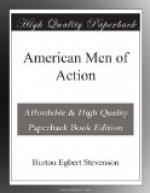The battle was soon over, after that, for the British boarded, the Chesapeake’s foreign crew threw down their arms, and the triumphant enemy hauled down the Chesapeake’s flag. A few days later, the two ships sailed into the harbor of Halifax, Lawrence’s body, wrapped in his ship’s flag, lying in state on the quarter-deck. He was buried with military honors, first at Halifax, and then at New York, where Hull, Stewart and Bainbridge were among those who carried the pall. His cry, “Don’t give up the ship!” was to be the motto of another battle, far to the west, where Great Britain experienced the greatest defeat of the war.
Before describing it, however, let us speak briefly of four other valiant men, whose deeds redounded to the honor of their country—Edward Preble, Charles Stewart, Johnston Blakeley, and Thomas Macdonough. It was said of Preble that he had the worst temper and the best heart in the world. At sixteen years of age he ran away to sea, and two years later, he actually saw a sea-serpent, a hundred and fifty feet in length and as big around as a barrel, and got close enough to fire at it. He saw service in the Revolution, and in 1803, was appointed to command the expedition against the Barbary corsairs, of which we have already spoken, and which resulted in bringing those pirates to their knees. The trials of that expedition ruined his health, and he survived it but a few years.
To Charles Stewart belongs the remarkable exploit of engaging and capturing two British ships at the same time. Enlisting in 1798, he was with Preble at Tripoli, and was given command of the Constitution, after Bainbridge’s successful cruise in her, and started out in search of adventure on December 17, 1814. Two months later, off the Madeira Islands he sighted two British ships-of-war and at once gave chase. He overhauled them at nightfall, and, running between them, gave them broadside after broadside, until both struck their colors. They were the Cyane and the Levant. Stewart got back to New York the middle of May to find out that peace had been declared over a month before his encounter with the British ships.
He was received with enthusiasm, and “Old Ironsides” got the reputation of being invincible. Her career had, indeed, been remarkable. She had done splendid work before Tripoli, escaped twice from British squadrons and seven times run the blockade through strong British fleets; she had captured three frigates and a sloop-of-war, besides many merchantmen, and had taken more than eleven hundred prisoners. From all of these engagements she had emerged practically unscathed, and in none of them had she lost more than nine men. Stewart was the last survivor of the great captains of 1812, living until 1869, having been carried on the navy list for seventy-one years.




